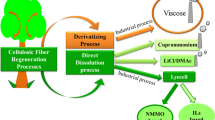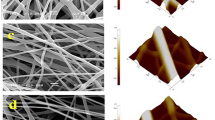Abstract
Solution blow spinning (SBS) is a process to produce non-woven fiber sheets with high porosity and an extremely large amount of surface area. In this study, a Box–Behnken experimental design (BBD) was used to optimize the processing parameters for the production of nanofibers from polymer solutions consisting of poly(lactic acid) (PLA) dissolved in dimethyl carbonate. In addition, a comparative study between SBS fibers and cast film was performed to verify the influence of the SBS process on the crystallinity and thermal properties of PLA. The PLA concentration in polymer solutions was the most significant parameter affecting fiber diameter. The BBD analysis revealed that small diameter fibers were best obtained by a combination of 8 % w/v PLA concentration, 80 psi air pressure, and a feed rate of 50 µL min−1. The comparative study showed that both the SBS and the film casting processes increased the PLA crystallinity. However, the PLA films had a higher degree of crystallinity compared with the fibers made by the SBS process (39 and 17 %, respectively), which was attributed to the high shear created at the SBS nozzle inducing orientation and chain alignment. During the fiber formation, crystals formed with varied morphology including the α′-crystals, which have a less ordered structure and lower thermal stability compared to the α-crystals. The lower thermal stability of SBS fibers compared to the films can be explained by the lower degree of crystallinity and also by the higher surface area which can accelerate the weight loss process.









Similar content being viewed by others
References
Medeiros ES, Glenn GM, Klamczynski AP et al (2009) Solution blow spinning: a new method to produce micro- and nanofibers from polymer solutions. J Appl Polym Sci 113:2322–2330. doi:10.1002/app30275
Medeiros ES, Glenn GM, Klamczynski AP, et al. (2014) US Patent 8,641,960: Solution Blow Spinning
Oliveira JE, Medeiros ES, Cardozo L et al (2013) Development of poly(lactic acid) nanostructured membranes for the controlled delivery of progesterone to livestock animals. Mater Sci Eng C 33:844–849. doi:10.1016/j.msec.2012.10.032
Zhuang X, Shi L, Jia K et al (2013) Solution blown nanofibrous membrane for microfiltration. J Memb Sci 429:66–70. doi:10.1016/j.memsci.2012.11.036
Behrens AM, Casey BJ, Sikorski MJ et al (2014) In situ deposition of PLGA nanofibers via solution blow spinning. ACS Macro Lett 3:249–254. doi:10.1021/mz500049x
Bolbasov EN, Anissimov YG, Pustovoytov a. V et al (2014) Ferroelectric polymer scaffolds based on a copolymer of tetrafluoroethylene with vinylidene fluoride: fabrication and properties. Mater Sci Eng C 40:32–41. doi:10.1016/j.msec.2014.03.038
Bilbao-Sainz C, Sen CB, Valenzuela-Medina D et al (2014) Solution blow spun poly(lactic acid)/hydroxypropyl methylcellulose nanofibers with antimicrobial properties. Eur Polym J 54:1–10. doi:10.1016/j.eurpolymj.2014.02.004
Liu R, Xu X, Zhuang X, Cheng B (2014) Solution blowing of chitosan/PVA hydrogel nanofiber mats. Carbohydr Polym 101:1116–1121. doi:10.1016/j.carbpol.2013.10.056
Oliveira JE, Mattoso LHC, Medeiros ES, Zucolotto V (2012) Poly(lactic acid)/carbon nanotube fibers as novel platforms for glucose biosensors. Biosensors 2:70–82. doi:10.3390/bios2010070
Oliveira JE, Moraes EA, Costa RGF et al (2011) Nano and submicrometric fibers of poly(d,l-lactide) obtained by solution blow spinning: process and solution variables. J Appl Polym Sci 122:3396–3405. doi:10.1002/app.34410
Oliveira JE, Mattoso LHC, Orts WJ, Medeiros ES (2013) Structural and morphological characterization of micro and nanofibers produced by electrospinning and solution blow spinning: a comparative study. Adv Mater Sci Eng. doi:10.1155/2013/409572
Oliveira JE, Moraes EA, Marconcini JM et al (2013) Properties of poly(lactic acid) and poly(ethylene oxide) solvent polymer mixtures and nanofibers made by solution blow spinning. J Appl Polym Sci 129:3672–3681. doi:10.1002/app.39061
Myers RH, Montgomery DC, Anderson-Cook CM (2009) Response surface methodology: process and product optimization using designed experiments, 3rd edn. John Wiley & Sons Inc, Hoboken
Neo YP, Ray S, Easteal AJ et al (2012) Influence of solution and processing parameters towards the fabrication of electrospun zein fibers with sub-micron diameter. J Food Eng 109:645–651. doi:10.1016/j.jfoodeng.2011.11.032
Salahi A, Noshadi I, Badrnezhad R et al (2013) Nano-porous membrane process for oily wastewater treatment: optimization using response surface methodology. J Environ Chem Eng 1:218–225. doi:10.1016/j.jece.2013.04.021
Konwarh R, Misra M, Mohanty AK, Karak N (2013) Diameter-tuning of electrospun cellulose acetate fibers: a Box-Behnken design (BBD) study. Carbohydr Polym 92:1100–1106. doi:10.1016/j.carbpol.2012.10.055
Pezeshki-Modaress M, Mirzadeh H, Zandi M (2015) Gelatin–GAG electrospun nanofibrous scaffold for skin tissue engineering: fabrication and modeling of process parameters. Mater Sci Eng C 48:704–712. doi:10.1016/j.msec.2014.12.023
Box GEP, Behnken DW (1960) Some new three level designs for the study of quantitative variables. Technometrics 2:455–475
Ferreira SLC, Bruns RE, Ferreira HS et al (2007) Box-Behnken design: an alternative for the optimization of analytical methods. Anal Chim Acta 597:179–186. doi:10.1016/j.aca.2007.07.011
Box GEP, Hunter WG, Hunter JS (2005) Statistics for experimenters: design, innovation, and discovery, 2nd edn. John Wiley & Sons Inc, Hoboken
Auras R, Lim L, Selke SEM, Tsuji H (2010) Poly (lactc acid): synthesis, structures, properties, processing and application. Wiley, New Jersey
Montgomery DC (1984) Design and analysis of experiments, 2nd edn. Wiley, New York
Hoogsteen W, Postema AR, Pennings AJ et al (1990) Crystal structure, conformation, and morphology of solution-spun poly(l-lactide) fibers. Macromolecules 23:634–642
Zhou H, Green TB, Joo YL (2006) The thermal effects on electrospinning of polylactic acid melts. Polymer (Guildf) 47:7497–7505. doi:10.1016/j.polymer.2006.08.042
Zhang J, Tashiro K, Tsuji H, Domb AJ (2008) Disorder-to-order phase transition and multiple melting behavior of poly(l-lactide) investigated by simultaneous measurements of WAXD and DSC. Macromolecules 41:1352–1357. doi:10.1021/ma0706071
Burgos N, Martino VP, Jiménez A (2013) Characterization and ageing study of poly(lactic acid) films plasticized with oligomeric lactic acid. Polym Degrad Stab 98:651–658. doi:10.1016/j.polymdegradstab.2012.11.009
Arruda LC, Magaton M, Bretas RES, Ueki MM (2015) Influence of chain extender on mechanical, thermal and morphological properties of blown films of PLA/PBAT blends. Polym Test 43:27–37. doi:10.1016/j.polymertesting.2015.02.005
Ma PM, Wang RY, Wang SF et al (2008) Effects of fumed silica on the crystallization behavior and thermal properties of poly(hydroxybutyrate-co-hydroxyvalerate). J Appl Polym Sci 108:1770–1777. doi:10.1002/app.27577
Acknowledgements
The authors thank NatureWorks® for the donation of PLA samples and WRRC-ARS-USDA and CAPES/CNPq (Science without Borders Program) for the financial support.
Author information
Authors and Affiliations
Corresponding author
Ethics declarations
Conflict of Interest
The authors declare that they have no conflict of interest.
Rights and permissions
About this article
Cite this article
da Silva Parize, D.D., Foschini, M.M., de Oliveira, J.E. et al. Solution blow spinning: parameters optimization and effects on the properties of nanofibers from poly(lactic acid)/dimethyl carbonate solutions. J Mater Sci 51, 4627–4638 (2016). https://doi.org/10.1007/s10853-016-9778-x
Received:
Accepted:
Published:
Issue Date:
DOI: https://doi.org/10.1007/s10853-016-9778-x




